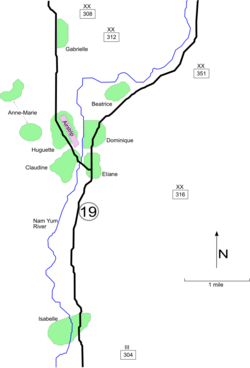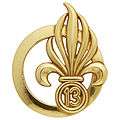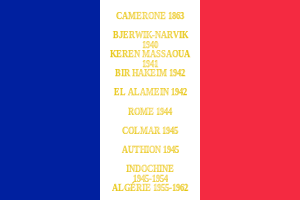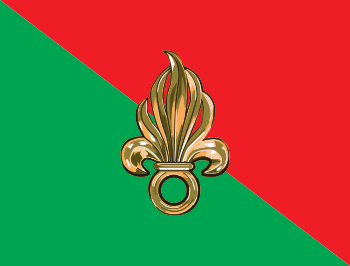13th Demi-Brigade of Foreign Legion
| 13th Half-Brigade of the Foreign Legion (13e Demi-Brigade de Légion Étrangère) | |
|---|---|
|
Badge of the 13th Foreign Legion Demi-Brigade | |
| Active | 20 February 1940 – present |
| Country |
|
| Allegiance |
|
| Branch |
|
| Type | Mechanized Infantry |
| Role |
Security Assistance Desert Warfare |
| Size | One battlegroup |
| Part of | Légion Étrangère |
| Garrison/HQ | United Arab Emirates |
| Nickname(s) |
The Demi Brigade (English) Phalange Magnifique (Magnificent Phalanx) |
| Motto(s) | More Majorum (after the custom (or manner) of our ancestors) |
| March |
Nos képis blancs (Sous le soleil brulant d'Afrique) |
| Anniversaries | Camerone Day (April 30) and Christmas |
| Engagements |
World War II *Battles of Narvik *Battle of Gabon *Syria-Lebanon Campaign *Battle of Bir Hakeim *Second Battle of El Alamein *Tunisia Campaign *Italian Campaign *Colmar Pocket *Western Allied invasion of Germany First Indochina War *Battle of Hoa Binh *Battle of Dien Bien Phu Algerian War *Operation Jumelles *Global War on Terrorism (2001–present) |
| Commanders | |
| Current commander | Colonel Nicolas HEUZE |
| Notable commanders |
Raoul Magrin-Vernerey Dimitri Amilakvari Gabriel Brunet de Sairigné Jules Gaucher Bernard Saint-Hillier |
| Insignia | |
| Insignia of the 13 Demi Brigade |
 |
| Abbreviation | 13e DBLE |

The 13th Demi-Brigade of Foreign Legion (French: 13e Demi-Brigade de Légion Étrangère, 13e DBLE) is a mechanized infantry demi-brigade of the French Foreign Legion. It is the only permanent demi-brigade in the French Army.
History
The 13e DBLE was raised in February 1939 at Sidi Bel Abbes in Algeria, with its cadre drawn from 1st Foreign Infantry Regiment (1eR R.E.I). The 13e DBLE fought during World War II for the Free French Forces including service at the Battle of Narvik and the Battle of Bir Hakeim. The unit fought in the French Indochina War and suffered heavy losses at the Battle of Dien Bien Phu.[1]
Narvik 1940

In January 1940, the British and French high commands had decided to dispatch an expedition to Finland, to support Finnish independence against the Soviet Union in the Winter War. The French decided to allocate a demi-brigade of legionnaires to the expedition – and 13e DBLE was born.
In March 1940, the 13e DBLE comprised 55 officers, 210 non-commissioned officers (sous-officiers), and 1,984 legionnaires. The average age of the legionnaires was between 26 and 28 years old, and most counted 4 to 5 years service. Many of its veteran NCOs had served in the Legion for 10 or more years. The demi-brigade's commander was Raoul Magrin-Vernerey, a hero of World War I, wounded 17 times in battle, who had served with the Legion since 1924[2] and was Inspector of the Foreign Legion from 1948 to 1950.
Finland reached an armistice agreement with the Soviet Union on 12 March, and the British and French high commands decided to dispatch their expedition instead to Norway – to deny the Germans access to the Norwegian ports. The 13e DBLE was transported to the Norwegian coast in the troopship Monarch of Britain, before transferring to Royal Navy motor torpedo boats, whalers, and Landing Craft Assault[3] on the morning of 13 May for the landing beaches at Bjerkvik, 8 miles (13 km) above Narvik. Once ashore, the 13e DBLE's companies deployed and moved to seize the high ground to the north and south of the town. The legionnaires overran the German camp at Elvegårdsmoen and forced the German rearguard out of Bjerkvik.[4]
On 28 May, the 13e DBLE moved on Narvik. The legionnaires crossed Rombaksfjorden and landed squarely in the middle of the German positions. German air attacks forced the supporting British ships to withdraw, leaving the 13e DBLE ashore without fire support. The legionnaires engaged in the difficult task of clearing-out German machine gun nests located in railway tunnels and concealed terrain. Lieutenant-Colonel Magrin-Vernerey commanded from the front, patrolling his front-lines to point out German positions to his troops with his walking stick.[5]
During the next 10 days, the Allied troops pushed the Germans to within 10 miles (20 km) of the Swedish frontier. Then, with the collapse of the French and British armies in France it was decided to cancel the Narvik operation and withdraw. The 13e DBLE evacuated Narvik on 7 June and was withdrawn to England. The unit had lost 7 officers, 5 NCOs, and 55 legionnaires during the campaign.[5]
Free French Forces
.svg.png)
In June 1940, the 13e DBLE moved to a camp at Trentham Park near Stoke-on-Trent in England where the legionnaires joined troops of the French Light Mountain Division who had been evacuated from Dunkirk. The 13e DBLE comprised 1,619 of the 4,500 French soldiers present in England.[6]
In France, Prime Minister Paul Reynaud resigned on 16 June and Marshal Pétain took control of the French government. Pétain announced his intention to capitulate to the Germans and sign an armistice. On 18 June, General Charles de Gaulle, under-secretary of defence in the Reynaud government, broadcast an appeal to the French people to continue resistance.
On 1 July, the French troops at Trentham Park were given the choice of repatriation to Vichy-controlled North Africa, or joining the Free French Forces under De Gaulle. The decision split the 13e DBLE between pro-Vichy and pro-De Gaulle cliques. The split was particularly felt amongst the officer corps, with 31 of the regiment's 59 officers choosing repatriation. Amongst the legionnaires, which included many refugees from Nazi and Fascist countries, around 900 volunteered to continue the fight.[7]
The 13th included a number of junior officers who would later rise to general rank, such as Captain Marie-Pierre Koenig, Captain Jacques Pâris de Bollardière, and Lieutenant Bernard Saint-Hillier. Other officers, such as Captain Dimitri Amilakvari and Captain Gabriel Brunet de Sairigné would also achieve fame on the battlefield. Second Lieutenant Pierre Messmer would later serve as De Gaulle's defence minister.
On 30 August the "Free French" 13th Demi-Brigade sailed from Liverpool for operations against Vichy forces that would include the abortive Battle of Dakar and the storming of Libreville.
Eritrea 1941
Syria 1941
Bir Hakeim 1942

The 13e DBLE was reorganized in two battalions following its participation in the successful Allied invasion of Syria (Operation Exporter). A disputed number of Legionnaires from the pro-Vichy 6th Foreign Infantry Regiment volunteered for service with the Free French 13e DBLE – the remainder of the pro-Vichy Legionnaires were repatriated to France in August 1941.
In 1942, the two battalions of 13e DBLE – designated 2nd battalion (II/13e DBLE) and 3rd battalion (III/13e DBLE) – were assigned to the 1st Free French Brigade commanded by General Koenig and joined the brigade at Bir Hakeim in Libya, approximately 90 miles (140 km) south of Tobruk. The French position sat astride the Afrika Korps' line of advance and represented a fortified "pocket" of resistance that had to be eliminated by General Erwin Rommel.
The battle of Bir Hakeim commenced on 26 May 1942. The 2/13e DBLE held positions along the east facade of the French line. The 3/13e DBLE formed mobile reserve groups to reinforce French positions at any threatened point. In bitter irony, the Legionnaires of 13e DBLE faced Afrika Korps troops that included the German 361st "Afrika" Infantry Regiment which contained former fellow-Legionnaires of German extraction who had been repriated from Vichy Legion units in North Africa.
Hoa Binh 1952
The 13e DBLE participated in the Battle of Hoa Binh from 14 November 1951 to 24 February 1952. Hoa Binh (the name means "peace" in Vietnamese) was the capital of the Muong ethnic minority. By road, Hoa Binh lay a mere 67 kilometers of map distance from Hanoi via Colonial Route 6 (Fr: Route Coloniale 6). The Viet Minh had controlled Hoa Binh since October 1950 and used the district as a logistics staging area for operations in north central Vietnam. The French commander in Indochina, General Jean de Lattre de Tassigny, ordered the retaking of Hoa Binh in late 1951.
The 2nd Battalion of 13e DBLE fought in a key engagement at Xon-Pheó from 8–9 January 1952. The legionnaires held a vital hill at Xon-Pheó astride Colonial Route 6, and they fortified their positions with trenches, bunkers, barbed wire, and minefields. On the night of 8 January, troops from the Viet Minh 88th Infantry Regiment infiltrated through the minefields and attacked the 2/13e DBLE positions. The Viet Minh forces overran the 5th Company position and destroyed bunkers with TNT satchel charges and Bangalore torpedoes. With many of their officers and NCOs killed or wounded, and half of their position overrun, the legionnaires counterattacked with fixed bayonets and hand grenades.
The legionnaires later counted 700 Viet Minh dead around the position at Xon-Pheó.
Dien Bien Phu 1953–1954

1st battalion (I/13e DBLE) and 3rd battalion (III/13e DBLE) fought at the Battle of Dien Bien Phu during the French Indochina War. At the commencement of the campaign, the demi-brigade was commanded by Lieutenant-colonel Jules Gaucher. During the early stages of the battle, I/13e DBLE occupied positions at stronghold "Claudine" and III/13e DBLE occupied positions at the "Béatrice" fortifications.
Lieutenant-colonel Gaucher was killed on the first day of the battle (13 March 1954), when his command post suffered a direct hit from Viet Minh artillery. Suffering from serious wounds – the loss of both arms, severe injuries to both legs, and an open chest wound – he died at the hospital. Gaucher was replaced as 13e DBLE commander on 23 March by Lieutenant-colonel Lemeunier who was helicoptered into the fortress. Until the end of the battle, Lemeunier would be the most senior Foreign Legion officer present at Dien Bien Phu.[8]
The unit suffered heavy casualties during fighting in March and April. On 14 April the Dien Bien Phu garrison reported that I/13e DBLE was reduced to 354 effectives and III/13e DBLE was reduced to 80 effectives.[9]
On 30 April, the legionnaires at Dien Bien Phu celebrated the anniversary of the Legion’s historic Battle of Camerone. The celebration took place at the 13e DBLE command post where Lieutenant-colonel Lemeunier read the traditional Camerone proclamation over a radio hook-up that could be heard throughout Dien Bien Phu.[10]
The 13e DBLE was the only French unit present at Dien Bien Phu that saved one of its battle flags from destruction or capture. The guidon of 4th Company, III/13e DBLE was initially captured by the Viet Minh during the assault on "Béatrice" on 13 March. On 19 May, while the Viet Minh were celebrating Ho Chi Minh’s birthday, Sergeant Beres, a Hungarian legionnaire serving with 1st Foreign Parachute Battalion (1er B.E.P), crawled into a Viet Minh command post and rescued the flag. The seriously wounded Beres was evacuated by helicopter from Dien Bien Phu on 24 May with the guidon hidden under his clothes.[11]
During its 9-year service in Indochina (1946–1955), the 13e DBLE suffered 2,721 killed in action (2334 légionaries, 307 warrant officers, 80 officers). This included two commanding officers – Lieutenant-colonel Brunet de Sairigné and Lieutenant-colonel Gaucher.[12]
Algeria 1955–1962

The 13e DBLE was reconstituted in May 1954 using the 2nd battalion (II/13e DBLE) as a cadre. In June 1955, the unit left Indochina and redeployed to French North Africa. During the Algerian War, the 13e DBLE served in Algiers, Constantine, and the Aurès Mountains. In 1958, the unit was assigned to duty as "régiment d'intervention" for operations throughout Algeria.
Recent Deployment
From 1962 to June 2011, the 13e DBLE duty station had been within Djibouti in the Horn of Africa. In June 2011 the unit was withdrawn from Djibouti to be redeployed permanently in the Abu Dhabi base, United Arab Emirates, as a result of a defense cooperation agreement with France.[13]
On 30 July 2015, the transfer of the 13e DBLE to the Camp du Larzac in Aveyron was announced for the year 2016. At the same time its strength will increase from 69 permanent staff to 390.
In 2018 its strength is due to reach 1,200 legionnaires formed into five combat companies, a headquarters company and a support company.
Recent Operations
In addition to its security responsibilities in Djibouti, the 13e DBLE has participated in military operations that include Operation ORYX and Operation UNOSOM II in Somalia (1992–1993) Operation ISKOUTIR (1993–1995), Operation TURQUOISE in Rwanda (1994), and Operation UNICORN in the Ivory Coast (2002)
Organization
The DBLE is a battalion-size unit specialized in infantry warfare. It is currently undergoing a phase of re-creation from a training unit to a combat unit. In 2016, it is organized in a half-sized Headquarters company (Compagnie de commandement) and two Combat companies (Compagnies de combat). Two new Combat companies will be created in 2017, as well as the Headquarters company getting its full complement. In 2018, the DBLE will get its final size with one more Combat company and a Recon and Support company (Compagnie d'éclairage et d'appui).[14]
Traditions
Insignia
-

Regimental Insignia of the 13e DBLE, other known as the "La Phalange Magnifique"
-

Insignia of the 13th Demi-Brigade of the Foreign Legion
Regimental Colors

Regimental Song
Chant de Marche : Nos Képis Blancs (Sous le soleil brulant d'Afrique) featuring:
1st couplet
Sous le soleil brûlant d'Afrique,
Cochinchine, Madagascar,
Une phalange magnifique,
A fait flotter nos étendards,
Sa devise «Honneur et vaillance»,
Forme des soldats valeureux,
Son drapeau celui de la France,
Est un emblème des plus glorieux.
Refrain
Vive la Légion étrangère,
Et quand défilent les képis blancs,
Si leur allure n'est pas légère,
Ils portent tous tête haute et fière,
Et s'élançant dans la fournaise,
Le cœur joyeux jamais tremblant,
Au son de notre Marseillaise,
Savent combattre les képis blancs.
2nd couplet
C'est une chose d'importance,
La discipline à la Légion,
L'amour du chef, l'obéissance
Sont de plus pure tradition,
Et pour notre France chérie,
Tous ces étrangers bravement,
Viennent défendre la patrie,
Avec honneur et dévouement.
Decorations
-
Fourragère at the ruban colors of the Croix de la libération -

Fourragère at the ruban colors of the Médaille militaire
The Regimental colors of the 13e DBLE is decorated with the following:
- The companion of the Order of Liberation
- 4 citations at the orders of the armed forces with attribution of the Croix de guerre 39-45
- 4 citations at the orders of the armed forces with attribution of the Croix de guerre des TOE
- Officer cross of the order of June 27 (independence order of the Djibouti).[15]
Battle Honours
- Camerone 1863[16]
- Bjerkvik-Narvik 1940
- Keren-Massouah 1941
- Bir-Hakeim 1942
- El Alamein 1942
- Rome 1944
- Colmar 1945
- Authion 1945
- Indochine 1946–1954
- AFN 1952-1962[17]
Regimental Commanders
- Lt. Col. Raoul Magrin-Vernerey (1940)
- Lt. Col. Alfred Cazoud (1940–1941)
- Lt. Col. Dimitri Amilakhvari (1941–1942)
- Major Gabriel Bablon (1942–1944)
- Major Paul Arnault (1944–1945)
- Lt. Col. Bernard Saint-Hillier (1945)
- Lt. Col. Gabriel Bablon (1946)
- Lt. Col. Gabriel Brunet de Sairigné (1946–1948)
- Lt. Col. Paul Arnaud (1948–1949)
- Lt. Col. René Morel (1949–1951)
- Lt. Col. Pierre Clément (1951–1953)
- Lt. Col. Guigard (1952–1953)
- Lt. Col. Jules Gaucher (1953–1954)
- Lt. Col. Lemeunier (1954)
- Lt. Col. Rossi (1954–1956)
- Lt. Col. Marguet (1956–1957)
- Lt. Col. Sanges (1957–1958)
- Lt. Col. Roux (1958–1961)
- Lt. Col. Vaillant (1961)
- Lt. Col. Dupuy de Querezieux (1961–1962)
- Lt. Col. Lacôte (1962–1965)
- Lt. Col. Geoffrey (1965–1968)
- Lt. Col. Foureau (1968–1970)
- Lt. Col. Buonfils (1970–1972)
- Lt. Col. Pêtre (1972–1974)
- Lt. Col. Paul Lardry (1974–1976)
- Col. Jean-Claude Coullon (1976-1978)
- Lt. Col. Gillet (1978–1980)
- Lt. Col. Loridon (1980–1982)
- Lt. Col. Vialle (1982–1984)
- Lt. Col. Rideau (1984–1986)
- Lt. Col. Champeau (1986–1988)
- Lt. Col. Le Flem (1988–1990)
- Colonel Ibanez (1990–1992)
- Colonel J.P. Perez (1992–1994)
- Lt. Col. Emmanuel Beth (1996–1998)
- Lt. Col. Debleds (1998–2000)
- Colonel Jean Maurin (2000–2002)
- Colonel Chavancy (2002–2004)
- Lt. Col. Henri Billaudel (2004–2006)
- Colonel Marchand (2006–2008)
- Colonel Thierry Burkhard (2008–2010)
- Colonel Cyrille Youchtchenko (2010–2011)
- Lt. Col. Tony Maffeis (2011–2013)
- Colonel Nicolas HEUZE (2013-20**)
Notable Officers and Legionnaires
See also
Notes
- ↑ Windrow, Martin (2005). The Last Valley: Dien Bien Phu and the French Defeat in Vietnam. Da Capo Press. p. 304. ISBN 978-0-306-81443-3.
- ↑ Porch, P466.
- ↑ Maund, p.41
- ↑ Porch, P468.
- 1 2 Porch, P469.
- ↑ Porch, P470.
- ↑ Porch, P473.
- ↑ Fall, P139-141.
- ↑ Fall, P248.
- ↑ Fall, P347.
- ↑ Fall, P431.
- ↑ (French) Défense
- ↑ La 13e DBLE quitte Djibouti
- ↑ (French)
- ↑ Képi Blanc (publication) n 735 - août-septembre 2011
- ↑ Camerone is a Battle Honour shared by all Foreign Legion Regiments, no matter when they were formed.
- ↑ Arrêté relatif à l'attribution de l'inscription AFN 1952-1962 sur les drapeaux et étendards des formations des armées et services, du 19 novembre 2004 (A) NORDEF0452926A Michèle Alliot-Marie
References
- Fall, Bernard. 1966 (2002). Hell in a Very Small Place: The Siege of Dien Bien Phu. Da Capo Press. ISBN 978-0-306-81157-9
- Maund, LEH. Assault From The Sea. London: Methuen, 1949.
- Porch, Douglas. The French Foreign Legion. New York: Harper Collins, 1991. ISBN 978-0-06-092308-2
- Windrow, Martin. 2004. The Last Valley. Da Capo Press. ISBN 978-0-306-81386-3
External links
| Wikimedia Commons has media related to 13th Demi-Brigade of Foreign Legion. |
- Official website – 13e Demi-brigade de Légion étrangère
- French Foreign Legion recruitment portal
- History of 13° DBLE (French text)
- Historique des Regiments – 13° Demi-Brigade Legion Etranger
- 13e DBLE's History (English) - History & images of the 13e DBLE



